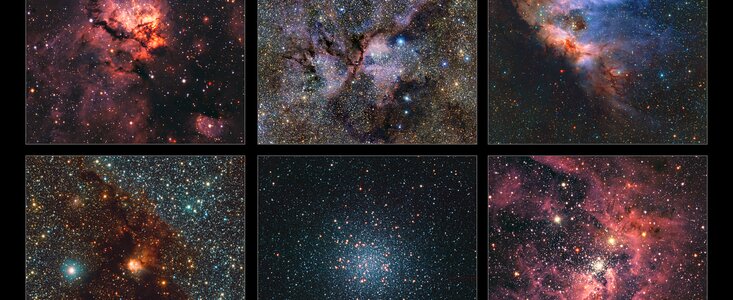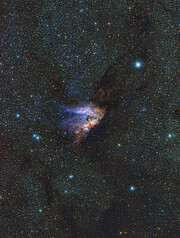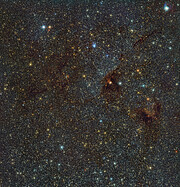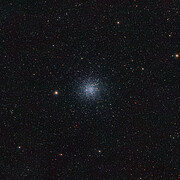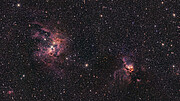Persbericht
ESO-telescoop maakt meest detailrijke infraroodkaart ooit van onze Melkweg
26 september 2024
Astronomen hebben een kolossale infraroodkaart van de Melkweg gepubliceerd die meer dan anderhalf miljard objecten omvat – de meest detailrijke die ooit is gemaakt. Met behulp van de VISTA-telescoop van de Europese Zuidelijke Sterrenwacht heeft het team meer dan dertien jaar lang de centrale delen van ons Melkwegstelsel waargenomen. Met vijfhonderd terabytes aan gegevens is dit het grootste waarneemproject dat ooit met een ESO-telescoop is uitgevoerd.
‘We hebben zo veel ontdekkingen gedaan, dat we de kijk op ons Melkwegstelsel voor altijd hebben veranderd,’ zegt Dante Minniti, astronoom aan de Universidad Andrés Bello in Chili die het project leidde.
De recordgrote kaart bestaat uit 200.000 opnamen die zijn gemaakt met ESO’s VISTA ― de Visible and Infrared Survey Telescope for Astronomy. Deze telescoop maakt deel uit van de ESO-sterrenwacht op Paranal in Chili, en heeft als hoofddoel het in kaart brengen van grote stukken hemel. Daarbij heeft het team VISTA’s infraroodcamera VIRCAM gebruikt, die door het stof en gas in ons sterrenstelsel heen kan kijken. Hij is daardoor in staat om straling van de best verstopte plekjes in de Melkweg te zien, en opent zo een uniek venster op onze galactische omgeving.
De enorme dataset [1] beslaat een hemelgebied ter grootte van 8600 vollemanen en bevat ongeveer tien keer zoveel objecten als een eerdere kaart die in 2012 door hetzelfde team is uitgebracht. Daartoe behoren onder meer pasgeboren sterren, die vaak zijn ingebed in cocons van stof, en bolvormige sterrenhopen ― compacte groepen van miljoenen van de oudste sterren in de Melkweg. Door infrarood licht te detecteren kan VISTA ook heel koude objecten waarnemen die op deze golflengten gloeien, zoals bruine dwergen (‘mislukte’ sterren die niet groot genoeg zijn om permanente kernfusiereacties in stand te houden) of solitaire planeten, die niet om sterren cirkelen.
De waarnemingen begonnen in 2010 en eindigden in de eerste helft van 2023. Alles bij elkaar namen ze 420 nachten in beslag. Door elk stukje hemel vele malen waar te nemen, kon het team niet alleen de posities van de objecten bepalen, maar ook hun bewegingen en eventuele helderheidsveranderingen volgen. Ze brachten sterren in kaart waarvan de helderheid periodiek verandert en die als kosmische ‘meetlatten’ kunnen worden gebruikt [2]. Hierdoor hebben we een nauwkeurig 3D-beeld gekregen van de centrale delen van de Melkweg, die tot voor kort aan het zicht onttrokken waren door stof. De onderzoekers hebben ook hypersnelle sterren gevolgd: snel bewegende sterren die uit het centrum van het Melkwegstelsel zijn gekatapulteerd na een kortstondige ontmoeting met het superzware zwarte gat dat daar op de loer ligt.
De nieuwe kaart bevat gegevens die zijn verzameld in het kader van de VISTA Variables in the Vía Láctea (VVV)-survey [3] en het bijbehorende project, de VVV eXtended (VVVX) survey. ‘Het project was een monumentale inspanning, mogelijk gemaakt door een geweldig team’, zegt Roberto Saito, astronoom aan de Universidade Federal de Santa Catarina in Brazilië en hoofdauteur van het artikel over de voltooiing van het project, dat vandaag in Astronomy & Astrophysics is gepubliceerd.
De VVV- en VVVX-surveys hebben al meer dan driehonderd wetenschappelijke artikelen opgeleverd. Hoewel de surveys nu zijn voltooid, zal de wetenschappelijke analyse van de verzamelde gegevens nog tientallen jaren doorgaan. Ondertussen wordt de ESO-sterrenwacht op Paranal voorbereid op de toekomst: VISTA wordt geüpdatet met het nieuwe instrument 4MOST en ESO’s Very Large Telescope (VLT) krijgt zijn MOONS-instrument. Samen zullen ze spectra afleveren van miljoenen van de objecten die nu in kaart zijn gebracht, wat naar verwachting ontelbare ontdekkingen zal opleveren.
Noten
[1] De dataset is te groot om in de vorm van één foto te publiceren, maar de bewerkte gegevens en de catalogus van objecten zijn toegankelijk via het ESO Science Portal.
[2] Eén van de manieren op de afstand van een ster te meten is door zijn schijnbare helderheid, zoals we die vanaf de aarde waarnemen, te vergelijken met zijn werkelijke helderheid. Bepaalde soorten sterren veranderen periodiek van helderheid en er is een sterk verband tussen hoe snel ze dit doen en hun intrinsieke helderheid. Door deze fluctuaties te meten, kunnen astronomen uitrekenen hoe helder deze sterren zijn en daarmee ook hoe ver weg ze staan.
[3] Vía Láctea is de Latijnse naam voor de Melkweg.
Meer informatie
De resultaten van dit onderzoek zijn te vinden in het artikel ‘The VISTA Variables in the Vía Láctea eXtended (VVVX) ESO public survey: Completion of the observations and legacy’, dat in Astronomy & Astrophysics verschijnt (https://doi.org/10.1051/0004-6361/202450584). Data DOI: VVV, VVVX.
Het onderzoeksteam bestaat uit: R.K. Saito (Departamento de Física, Universidade Federal de Santa Catarina, Florianópolis, Brazilië [UFSC]), M. Hempel (Instituto de Astrofísica, Dep. de Ciencias Físicas, Facultad de Ciencias Exactas, Universidad Andres Bello, Providencia, Chili [ASTROUNAB] en het Max-Planck-Institut für Astronomie, Heidelberg, Duitsland), J. Alonso-García (Centro de Astronomía, Universidad de Antofagasta, Antofagasta, Chili [CITEVA] en het Millennium Institute of Astrophysics, Providencia, Chili [MAS]), P.W. Lucas (Centre for Astrophysics Research, University of Hertfordshire, Hatfield, Verenigd Koninkrijk [CAR]), D. Minniti (ASTROUNAB; Vaticaan-sterrenwacht, Vaticaanstad [VO] en UFSC), S. Alonso (Departamento de Geofísica y Astronomía, CONICET, Facultad de Ciencias Exactas, Físicas y Naturales, Universidad Nacional de San Juan, Rivadavia, Argentinië [UNSJ-CONICET]), L. Baravalle (Instituto de Astronomía Teórica y Experimental, Córdoba, Argentina [IATE-CONICET]; Observatorio Astronómico de Córdoba, Universidad Nacional de Córdoba, Argentina [OAC]), J. Borissova (Instituto de Física y Astronomía, Universidad de Valparaíso, Valparaíso, Chili [IFA-UV] en MAS), C. Caceres (ASTROUNAB), A. N. Chené (Gemini Observatory, Northern Operations Center, Hilo, USA), N.J.G. Cross (Wide-Field Astronomy Unit, Institute for Astronomy, University of Edinburgh, Royal Observatory, Edinburgh, Verenigd Koninkrijk), F. Duplancic (UNSJ-CONICET), E.R. Garro (Europese Zuidelijke Sterrenwacht, Vitacura, Chili [ESO Chile]), M. Gómez (ASTROUNAB), V. D. Ivanov (Europese Zuidelijke Sterrenwacht, Garching bei München [ESO Duitsland]), R. Kurtev (IFA-UV en MAS), A. Luna (INAF – Osservatorio Astronomico di Capodimonte, Napoli, Italië [INAF- OACN]), D. Majaess (Mount Saint Vincent University, Halifax, Canada), M.G. Navarro (INAF – Osservatorio Astronomico di Roma, Italië [INAF-OAR]), J.B. Pullen (ASTROUNAB), M. Rejkuba (ESO Duitsland), J.L. Sanders (Department of Physics and Astronomy, University College London, Londen, Verenigd Koninkrijk), L.C. Smith (Institute of Astronomy, University of Cambridge, Cambridge, Verenigd Koninkrijk), P.H.C. Albino (UFSC), M.V. Alonso (IATE-CONICET en OAC), E.B. Amôres (Departamento de Física, Universidade Estadual de Feira de Santana, Feira de Santana, Brazilië), E.B.R. Angeloni (Gemini Observatory/NSF’s NOIRLab, La Serena, Chili [NOIRLab]), J.I. Arias (Departamento de Astronomía, Universidad de La Serena, La Serena, Chili [ULS]), M. Arnaboldi (ESO Duitsland), B. Barbuy (Universidade de São Paulo, São Paulo, Brazilië), A. Bayo (ESO Duitsland), J.C. Beamin (ASTROUNAB en Fundación Chilena de Astronomía, Santiago, Chili), L.R. Bedin (Istituto Nazionale di Astrofisica, Osservatorio Astronomico di Padova, Padua, Italië [INAF-OAPd]), A. Bellini (Space Telescope Science Institute, Baltimore, VS [STScI]), R.A. Benjamin (Department of Physics, University of Wisconsin-Whitewater, Whitewater, VS), E. Bica (Departamento de Astronomia, Instituto de Física, Porto Alegre, Brazilië [IF – UFRGS]), C.J. Bonatto (IF – UFRGS), E. Botan (Instituto de Ciências Naturais, Humanas e Sociais, Universidade Federal de Mato Grosso, Sinop, Brazilië), V.F. Braga (INAF-OAR), D.A. Brown (Vatican Observatory, Tucson, VS), J.B. Cabral (IATE-CONICET en Gerencia De Vinculación Tecnológica, Comisión Nacional de Actividades Espaciales, Córdoba, Argentinië), D. Camargo (Colégio Militar de Porto Alegre, Ministério da Defesa, Exército Brasileiro, Brazilië), A. Caratti o Garatti (INAF- OACN), J.A. Carballo-Bello (Instituto de Alta Investigación, Universidad de Tarapacá, Arica, Chili [IAI-UTA]), M.Catelan (Instituto de Astrofísica, Pontificia Universidad Católica de Chile, Santiago, Chili [Instituto de Astrofísica UC]; MAS en Centro de Astro-Ingeniería, Pontificia Universidad Católica de Chile, Santiago, Chili [AIUC]), C. Chavero (OAC en Consejo Nacional de Investigaciones Científica y Técnicas, Ciudad Autónoma de buenos Aires, Argentina [CONICET]), M.A. Chijani (ASTROUNAB), J.J. Clariá (OAC en CONICET), G.V. Coldwell (UNSJ-CONICET), C. Contreras Peña (Department of Physics and Astronomy, Seoul National University, Seoul, Republiek Korea en Research Institute of Basic Sciences, Seoul National University, Seoul, Republiek Korea), C.R. Contreras Ramos (Instituto de Astrofísica UC en MAS), J.M. Corral-Santana (ESO Chile), C.C. Cortés (Departamento de Tecnologías Industriales, Faculty of Engineering, Universidad de Talca, Curicó, Chili), M. Cortés-Contreras (Departamento de Física de la Tierra y Astrofísica & Instituto de Física de Partículas y del Cosmos de la UCM, Facultad de Ciencias Físicas, Universidad Complutense de Madrid, Madrid, Spanje), P. Cruz (Centro de Astrobiología, CSIC-INTA, Madrid, Spanje [CAB]), I.V. Daza-Perilla (CONICET; IATE-CONICET en Facultad de Matemática, Astronomía, Física y Computación, Universidad Nacional de Córdoba, Córdoba, Argentinië), V. P. Debattista (University of Central Lancashire, Preston, Verenigd Konikrijk), B. Dias (ASTROUNAB), L. Donoso (Instituto de Ciencias Astronómicas, de la Tierra y del Espacio, San Juan, Argentinië), R. D’Souza (VO), J.P. Emerson (Astronomy Unit, School of Physical and Chemical Sciences, Queen Mary University of London, Londen, Verenigd Koninkrijk), S. Federle (ESO Chile en ASTROUNAB), V. Fermiano (UFSC), J. Fernandez (UNSJ-CONICET), J.G. Fernández-Trincado (Instituto de Astronomía, Universidad Católica del Norte, Antofagasta, Chili [IA-UCN]), T. Ferreira (Department of Astronomy, Yale University, New Haven, VS), C.E. Ferreira Lopes (Instituto de Astronomía y Ciencias Planetarias, Universidad de Atacama, Copiapó, Chili [INCT] en MAS), V. Firpo (NOIRLab), C. Flores-Quintana (ASTROUNAB en MAS), L. Fraga (Laboratorio Nacional de Astrofísica, Itajubá, Brazilië), D.Froebrich (Centre for Astrophysics and Planetary Science, School of Physics and Astronomy, University of Kent, Canterbury, Verenigd Koninkrijk), D. Galdeano (UNSJ-CONICET), I. Gavignaud (ASTROUNAB), D. Geisler (Departamento de Astronomía, Universidad de Concepción, Chili [UdeC]; Instituto Multidisciplinario de Investigación y Postgrado, Universidad de La Serena, Chili [IMIP-ULS] en ULS), O.E.Gerhard (Max-Planck-Institut für extraterrestrische Physik, Duitsland [MPE]), W. Gieren (UdeC), O.A. Gonzalez (UK Astronomy Technology Centre, Royal Observatory Edinburgh, Edinburgh, Verenigd Koninkrijk), L.V. Gramajo (OAC en CONICET), F. Gran (Université Côte d’Azur, Observatoire de la Côte d’Azur, CNRS, Laboratoire Lagrange, Nice, Frankrijk [Lagrange]), P. M. Granitto (Centro Internacional Franco Argentino de Ciencias de la Información y de Sistemas, Rosario, Argentinië), M. Griggio (INAF-OAPd; Dipartimento di Fisica, Università di Ferrara, Ferrara, Italië en STScI), Z. Guo (IFA-UV en MAS), S. Gurovich (IATE-CONICET en Western Sydney University, Kingswood, Australië), M. Hilker (ESO Duitsland), H.R.A. Jones (CAR), R. Kammers (UFSC), M.A. Kuhn (CAR), M.S.N. Kumar (Centro de Astrofísica da Universidade do Porto, Porto, Portugal), R. Kundu (Miranda House, University of Delhi, India en Inter University centre for Astronomy and Astrophysics, Pune, India), M. Lares (IATE-CONICET), M. Libralato (INAF-OAPd), E. Lima (Universidade Federal do Pampa, Uruguaiana, Brazilië), T. J. Maccarone (Department of Physics & Astronomy, Texas Tech University, Lubbock, VS), P. Marchant Cortés (ULS), E. L. Martin (Instituto de Astrofisica de Canarias en Departamento de Astrofísica, Universidad de La Laguna, San Cristóbal de la Laguna, Spanje), N. Masetti (Istituto Nazionale di Astrofisica, Osservatorio di Astrofisica e Scienza dello Spazio di Bologna, Bologna, Italië en ASTROUNAB), N. Matsunaga (Department of Astronomy, Graduate School of Science, The University of Tokyo, Japan), F. Mauro (IA-UCN), I. McDonald (Jodrell Bank Centre for Astrophysics, The University of Manchester, VK [JBCA]), A. Mejías (Departamento de Astronomía, Universidad de Chile, Las Condes, Chili), V. Mesa (IMIP-ULS; Association of Universities for Research in Astronomy, Chili, Grupo de Astrofísica Extragaláctica-IANIGLA; CONICET, en Universidad Nacional de Cuyo, Mendoza, Argentinië), F.P. Milla-Castro (ULS), J.H. Minniti (Department of Physics and Astronomy, Johns Hopkins University, Baltimore, VS), C. Moni Bidin (IA-UCN), K. Montenegro (Clínica Universidad de los Andes, Santiago, Chili), C. Morris (CAR), V. Motta (OAC), F. Navarete (SOAR Telescope/NSF’s NOIRLab, La Serena, Chili), C. Navarro Molina (Centro de Docencia Superior en Ciencias Básicas, Universidad Austral de Chile, Puerto Montt, Chili), F. Nikzat (Instituto de Astrofísica UC en MAS), J.L. NiloCastellón (IMIP-ULS en ULS), C. Obasi (IA-UCN en Centre for Basic Space Science, University of Nigeria, Nsukka, Nigeria), M. Ortigoza-Urdaneta (Departamento de Matemática, Universidad de Atacama, Copiapó, Chili), T. Palma (OAC), C. Parisi (OAC en IATE-CONICET), K. Pena Ramírez (NSF NOIRLab/Vera C. Rubin Observatory, La Serena, Chili), L. Pereyra (IATE-CONICET), N. Perez (UNSJ-CONICET), I. Petralia (ASTROUNAB), A. Pichel (Instituto de Astronomía y Física del Espacio, Ciudad Autónoma de Buenos Aires, Argentinië [IAFE-CONICET]), G. Pignata (IAI-UTA), S. Ramírez Alegría (CITEVA), A.F. Rojas (Instituto de Astrofísica UC, Instituto de Estudios Astrofísicos, Facultad de Ingeniería y Ciencias, Universidad Diego Portales, Santiago, Chili en CITEVA), D. Rojas (ASTROUNAB), A. Roman-Lopes (ULS), A. C. Rovero (IAFE-CONICET), S. Saroon (ASTROUNAB), E.O. Schmidt (OAC en IATE-CONICET), A.C. Schröder (MPE), M. Schultheis (Lagrange), M.A. Sgró (OAC), E. Solano (CAB), M. Soto (INCT), B. Stecklum (Thüringer Landessternwarte, Tautenburg, Duitsland), D. Steeghs (Department of Physics, University of Warwick, VK), M. Tamura (Department of Astronomy, Graduate School of Science, University of Tokyo; Astrobiology Center, Tokyo, Japan, en National Astronomical Observatory of Japan, Tokyo, Japan), P. Tissera (Instituto de Astrofísica UC en AIUC), A.A.R. Valcarce (Departamento de Física, Universidad de Tarapacá, Chili), C.A. Valotto (IATE-CONICET en OAC), S. Vasquez (Museo Interactivo de la Astronomía, La Granja, Chili), C. Villalon (IATE-CONICET en OAC), S. Villanova (UdeC), F. Vivanco Cádiz (ASTROUNAB), R. Zelada Bacigalupo (North Optics, La Serena, Chili), A. Zijlstra (JBCA en School of Mathematical and Physical Sciences, Macquarie University, Sydney, Australië), en M. Zoccali (Instituto de Astrofísica UC en MAS).
De Europese Zuidelijke Sterrenwacht (ESO) stelt wetenschappers van over de hele wereld in staat om de geheimen van het heelal te ontdekken, ten bate van iedereen. Wij ontwerpen, bouwen en exploiteren observatoria van wereldklasse die door astronomen worden gebruikt om spannende vragen te beantwoorden en de fascinatie voor astronomie te verspreiden, en bevorderen internationale samenwerking op het gebied van de astronomie. ESO, in 1962 opgericht als intergouvernementele organisatie, wordt inmiddels gedragen door 16 lidstaten (België, Denemarken, Duitsland, Finland, Frankrijk, Ierland, Italië, Nederland, Oostenrijk, Polen, Portugal, Spanje, Tsjechië, het Verenigd Koninkrijk, Zweden en Zwitserland) en door het gastland Chili, met Australië als strategische partner. Het hoofdkwartier van de ESO en haar bezoekerscentrum en planetarium, de ESO Supernova, zijn gevestigd nabij München in Duitsland, maar onze telescopen staan opgesteld in de Chileense Atacama-woestijn – een prachtige plek met unieke omstandigheden voor het doen van hemelwaarnemingen. ESO exploiteert drie waarnemingslocaties: La Silla, Paranal en Chajnantor. Op Paranal staan ESO’s Very Large Telescope en Very Large Telescope Interferometer, evenals surveytelescopen zoals VISTA. Ook zal ESO op Paranal de Cherenkov Telescope Array South huisvesten en exploiteren – ’s werelds grootste en gevoeligste observatorium van gammastraling. Samen met internationale partners beheert ESO APEX en ALMA op Chajnantor, twee faciliteiten die de hemel waarnemen in het millimeter- en submillimetergebied. Op Cerro Armazones, nabij Paranal, bouwen wij ‘het grootste oog ter wereld’ – ESO’s Extremely Large Telescope. Vanuit onze kantoren in Santiago, Chili, ondersteunen wij onze activiteiten in het gastland en werken wij samen met Chileense partners en de Chileense samenleving.
Links
- Onderzoeksartikel
- Foto's van de surveytelescopen op Paranal, waaronder VISTA
- Voor journalisten: abonneer je op onze perberichten in je eigen taal
- Voor wetenschappers: heb je een verhaal? Promoot je onderzoek
Contact
Roberto K. Saito
Universidade Federal de Santa Catarina
Florianópolis, Brazil
E-mail: roberto.saito@ufsc.br
Dante Minniti
Universidad Andrés Bello
Santiago, Chile
E-mail: vvvdante@gmail.com
Phil Lucas
University of Hertfordshire
Hartfield, United Kingdom
E-mail: p.w.lucas@herts.ac.uk
Juan Carlos Muñoz-Mateos
ESO Media Officer
Garching bei München, Germany
Tel: +49 89 3200 6176
E-mail: press@eso.org
Marieke Baan (Perscontact Nederland)
ESO Science Outreach Network
en NOVA Informatie Centrum
Tel: +31(0)20-5257480
E-mail: eson-netherlands@eso.org
Over dit bericht
| Persberichten nr.: | eso2413nl |
| Naam: | Milky Way |
| Type: | Milky Way |
| Facility: | Visible and Infrared Survey Telescope for Astronomy |
| Instruments: | VIRCAM |
| Science data: | 2024A&A...689A.148S |
Our use of Cookies
We use cookies that are essential for accessing our websites and using our services. We also use cookies to analyse, measure and improve our websites’ performance, to enable content sharing via social media and to display media content hosted on third-party platforms.
ESO Cookies Policy
The European Organisation for Astronomical Research in the Southern Hemisphere (ESO) is the pre-eminent intergovernmental science and technology organisation in astronomy. It carries out an ambitious programme focused on the design, construction and operation of powerful ground-based observing facilities for astronomy.
This Cookies Policy is intended to provide clarity by outlining the cookies used on the ESO public websites, their functions, the options you have for controlling them, and the ways you can contact us for additional details.
What are cookies?
Cookies are small pieces of data stored on your device by websites you visit. They serve various purposes, such as remembering login credentials and preferences and enhance your browsing experience.
Categories of cookies we use
Essential cookies (always active): These cookies are strictly necessary for the proper functioning of our website. Without these cookies, the website cannot operate correctly, and certain services, such as logging in or accessing secure areas, may not be available; because they are essential for the website’s operation, they cannot be disabled.
Functional Cookies: These cookies enhance your browsing experience by enabling additional features and personalization, such as remembering your preferences and settings. While not strictly necessary for the website to function, they improve usability and convenience; these cookies are only placed if you provide your consent.
Analytics cookies: These cookies collect information about how visitors interact with our website, such as which pages are visited most often and how users navigate the site. This data helps us improve website performance, optimize content, and enhance the user experience; these cookies are only placed if you provide your consent. We use the following analytics cookies.
Matomo Cookies:
This website uses Matomo (formerly Piwik), an open source software which enables the statistical analysis of website visits. Matomo uses cookies (text files) which are saved on your computer and which allow us to analyze how you use our website. The website user information generated by the cookies will only be saved on the servers of our IT Department. We use this information to analyze www.eso.org visits and to prepare reports on website activities. These data will not be disclosed to third parties.
On behalf of ESO, Matomo will use this information for the purpose of evaluating your use of the website, compiling reports on website activity and providing other services relating to website activity and internet usage.
Matomo cookies settings:
Additional Third-party cookies on ESO websites: some of our pages display content from external providers, e.g. YouTube.
Such third-party services are outside of ESO control and may, at any time, change their terms of service, use of cookies, etc.
YouTube: Some videos on the ESO website are embedded from ESO’s official YouTube channel. We have enabled YouTube’s privacy-enhanced mode, meaning that no cookies are set unless the user actively clicks on the video to play it. Additionally, in this mode, YouTube does not store any personally identifiable cookie data for embedded video playbacks. For more details, please refer to YouTube’s embedding videos information page.
Cookies can also be classified based on the following elements.
Regarding the domain, there are:
- First-party cookies, set by the website you are currently visiting. They are stored by the same domain that you are browsing and are used to enhance your experience on that site;
- Third-party cookies, set by a domain other than the one you are currently visiting.
As for their duration, cookies can be:
- Browser-session cookies, which are deleted when the user closes the browser;
- Stored cookies, which stay on the user's device for a predetermined period of time.
How to manage cookies
Cookie settings: You can modify your cookie choices for the ESO webpages at any time by clicking on the link Cookie settings at the bottom of any page.
In your browser: If you wish to delete cookies or instruct your browser to delete or block cookies by default, please visit the help pages of your browser:
Please be aware that if you delete or decline cookies, certain functionalities of our website may be not be available and your browsing experience may be affected.
You can set most browsers to prevent any cookies being placed on your device, but you may then have to manually adjust some preferences every time you visit a site/page. And some services and functionalities may not work properly at all (e.g. profile logging-in, shop check out).
Updates to the ESO Cookies Policy
The ESO Cookies Policy may be subject to future updates, which will be made available on this page.
Additional information
For any queries related to cookies, please contact: pdprATesoDOTorg.
As ESO public webpages are managed by our Department of Communication, your questions will be dealt with the support of the said Department.
